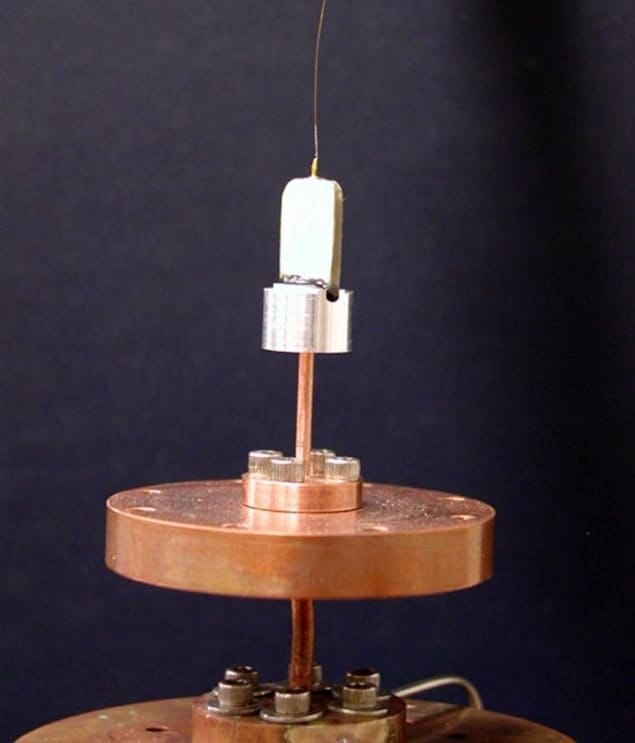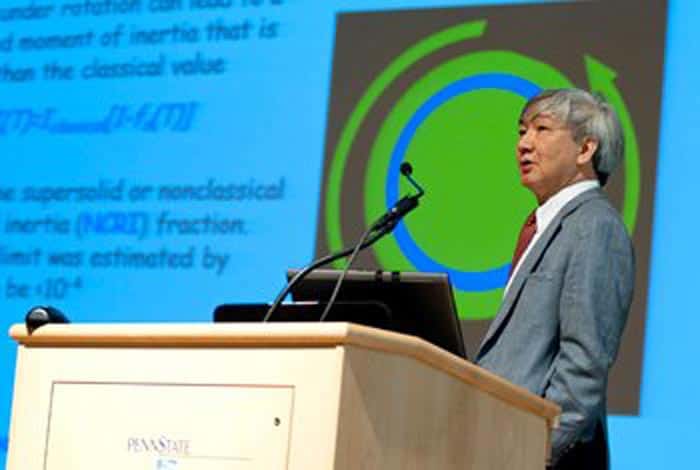
In 2004 Moses Chan and his graduate student Eun-Seong Kim thought that they had made one of the most exciting condensed-matter discoveries of the new century. It was the supersolid – a mysterious substance that could float through ordinary solids, like a ghost through walls. Now the Penn State University physicist has published a paper arguing that his initial interpretation was wrong – a mundane materials effect rather than supersolidity was the cause of their anomalous experimental results. “It would have been nice if the supersolid [interpretation] was correct,” he says, “but Mother Nature had her own way.”
The paper comes after Chan and others struggled for eight years to produce conclusive evidence for the effect. Although the experiments have been a disappointment, they were not done on a whim. The supersolid concept has a long history and theoretical physicists – including Nobel laureate Philip Anderson – have developed compelling arguments for its existence.
The saga began in 1969, when Russian theorists Alexander Andreev and Ilya Liftshitz predicted that, at very low temperatures, any vacancies left in an atomic lattice would “condense” into the lowest quantum state, forming a single entity. Since atomic vacancies are normally created by thermal energy, most solids are vacancy free at low temperature. But this might not be true of helium-4, in which atoms are so weakly bound that they can be knocked out of place by tiny quantum fluctuations. In principle, this collective state of condensed vacancies would flow through the solid unimpeded. This motion could be detected as an unimpeded superfluid-like flow of atoms in the opposite direction – hence a supersolid.
Strong, positive results
Chan and Kim were not the first to test Andreev and Liftshitz’s idea in the lab, but they were the first to get strong, positive results. Beginning in 1999, the physicists created a “torsional oscillator” – a fat, hollow cylinder hung on a twisting rod – which they filled with porous glass. Through the rod they injected helium-4 into the glass, and monitored the frequency of the cylinder’s oscillations as they brought down the temperature to absolute zero. At 175 mK, they noticed a sudden drop in the oscillation period. Kim and Chan interpreted this as a sign that some of the helium-4 had formed a supersolid, detaching itself from the oscillations as it passed effortlessly through the rest of the helium lattice.
The results were published in a 2004 letter to Nature entitled “Probable observation of a supersolid helium phase” and provoked a storm of interest. Many physicists struggled to understand the new phase of matter – and in particular, why it seemed to occur in some experiments but not others. Then in 2007 John Beamish and James Day, a pair of experimentalists at the University of Alberta in Canada, fired a bombshell: what if the reported signals had nothing to do with supersolidity, but basic material science? According to the Alberta researchers, a period drop could also be caused by a low-temperature stiffening of “dislocation lines” in bulk helium.
At first, Chan calculated that the contribution of the stiffening effect should be relatively small. But in time he realized that he had underestimated: rather than existing in isolation, the helium glued the whole cell together, and any stiffening would extend throughout. Last year, Chan and colleagues from Penn State and the University of Delaware designed a new, stiffer oscillator that would not be affected so much by elastic changes in the helium. In that experiment, the period drop was very small – the same order of magnitude as predicted by helium stiffening alone.
Worrying result
It was a worrying result, but it still left open the possibility that there was a combined effect of stiffening and supersolidity. Chan went back to his original 2004 experiment, and considered all the places where stiffening could occur. The way the helium was injected into the cell required a thin gap above the porous glass; here, bulk helium – and dislocations – could exist. This year, Chan and his postdoc Duk Kim redesigned the oscillator again, removing the gap. The result: no period drop, and no supersolidity.
I’ve been worrying about [stiffening] since 2007!
Moses Chan, Penn State University
“We didn’t realize that the [stiffening] could have such a dramatic effect at low temperature,” says Chan. “That’s the thing that took us so long – that is, in a way, embarrassing.” Yet despite the embarrassment, Chan shows signs of relief. “It’s not as dramatic as you might think,” he laughs. “I’ve been worrying about it since 2007!”
Not everyone is convinced that the story is over. Anderson believes supersolidity must exist from a theoretical point of view, although it may be that the phenomenon is too subtle for current instruments. And he is not the only hold-out: Chan’s ex-student Eun-Seong Kim, who now heads the Center for Supersolid and Quantum Matter Research at the Korea Advanced Institute of Science and Technology, insists that some results cannot be explained by the stiffening hypothesis.
Chan does not like to comment on his former student’s position. “We are very friendly with each other,” he says. “He is frustrated with me, but I suppose – well, we had to report what we see.”
Supersolid research has been a good example of how science works
John Beamish, University of Alberta
Other condensed-matter physicists – some of whom have also performed experiments to discredit the original supersolid interpretation – are supportive of Chan. Beamish describes how the Penn State researcher pursued the science with “amazing energy, even when his new experiments disagreed with his interpretation of his initial experiments.” Supersolid research, says Beamish, “has been a good example of how science works.”
Chan agrees. Like a detective novel, he says, the culprit is not always the most exciting part; it is the chase that provides the excitement. But does this mean he has lost all hope of finding supersolidity? Not quite: “Let me put it precisely,” he says. “Any supersolids greater than two or three parts in 10 to the minus five do not exist.”
Chan’s latest paper on supersolids is published in Physical Review Letters.




